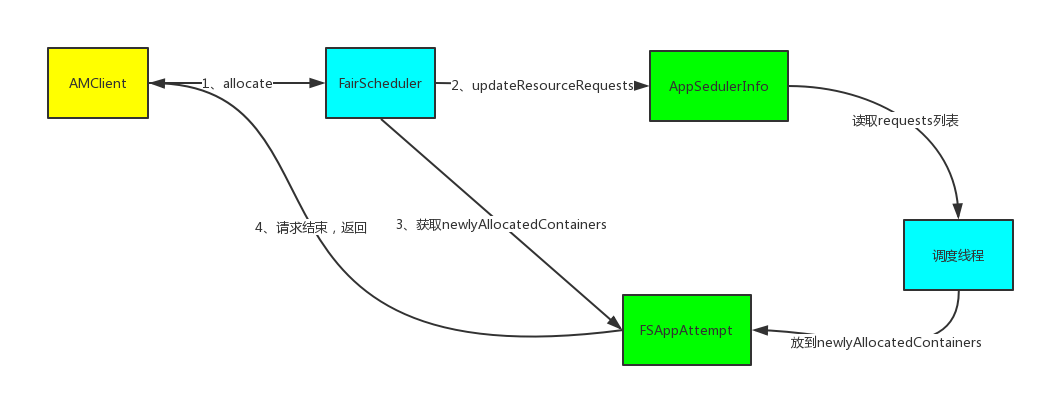Hadoop源碼系列(一)FairScheduler申請和分配container的過程
1、如何申請資源
1.1 如何啟動AM並申請資源
1.1.1 如何啟動AM
val yarnClient = YarnClient.createYarnClient setupCredentials() yarnClient.init(yarnConf) yarnClient.start() // Get a new application from our RM val newApp = yarnClient.createApplication() val newAppResponse = newApp.getNewApplicationResponse() appId = newAppResponse.getApplicationId()// Set up the appropriate contexts to launch our AM val containerContext = createContainerLaunchContext(newAppResponse) val appContext = createApplicationSubmissionContext(newApp, containerContext) // Finally, submit and monitor the application logInfo(s"Submitting application $appId to ResourceManager") yarnClient.submitApplication(appContext)
1.1.2 FairScheduler如何處理AM的ResourceRequest
1、FairScheduler接收到SchedulerEventType.APP_ADDED之後,調用addApplication方法把把RMApp添加到隊列裏面,結束之後發送RMAppEventType.APP_ACCEPTED給RMApp
2、RMApp啟動RMAttempt之後,發送SchedulerEventType.APP_ATTEMPT_ADDED給FairScheduler
LOG.info("Added Application Attempt " + applicationAttemptId + " to scheduler from user: " + user);3、FairScheduler調用addApplicationAttempt方法,發送RMAppAttemptEventType.ATTEMPT_ADDED事件給RMAppAttempt,RMAppAttempt隨後調用Scheduler的allocate方法發送AM的ResourceRequest
4、FairScheduler在allocate方法裏面對該請求進行處理,FairScheduler對於AM的資源請求的優先級上並沒有特殊的照顧,詳細請看章節2 如何分配資源
1.2 AM啟動之後如何申請資源
1.2.1、註冊AM
amClient = AMRMClient.createAMRMClient()
amClient.init(conf)
amClient.start()
amClient.registerApplicationMaster(Utils.localHostName(), 0, uiAddress)
1.2.2、發送資源請求
// 1.創建資源請求 amClient.addContainerRequest(request) // 2.發送資源請求 val allocateResponse = amClient.allocate(progressIndicator) val allocatedContainers = allocateResponse.getAllocatedContainers() if (allocatedContainers.size > 0) { // 3.請求返回之後處理Container handleAllocatedContainers(allocatedContainers.asScala) }
1.2.3、啟動Container

def startContainer(): java.util.Map[String, ByteBuffer] = { val ctx = Records.newRecord(classOf[ContainerLaunchContext]) .asInstanceOf[ContainerLaunchContext] val env = prepareEnvironment().asJava ctx.setLocalResources(localResources.asJava) ctx.setEnvironment(env) val credentials = UserGroupInformation.getCurrentUser().getCredentials() val dob = new DataOutputBuffer() credentials.writeTokenStorageToStream(dob) ctx.setTokens(ByteBuffer.wrap(dob.getData())) val commands = prepareCommand() ctx.setCommands(commands.asJava) ctx.setApplicationACLs(YarnSparkHadoopUtil.getApplicationAclsForYarn(securityMgr).asJava) // If external shuffle service is enabled, register with the Yarn shuffle service already // started on the NodeManager and, if authentication is enabled, provide it with our secret // key for fetching shuffle files later if (sparkConf.get(SHUFFLE_SERVICE_ENABLED)) { val secretString = securityMgr.getSecretKey() val secretBytes = if (secretString != null) { // This conversion must match how the YarnShuffleService decodes our secret JavaUtils.stringToBytes(secretString) } else { // Authentication is not enabled, so just provide dummy metadata ByteBuffer.allocate(0) } ctx.setServiceData(Collections.singletonMap("spark_shuffle", secretBytes)) } // Send the start request to the ContainerManager try { nmClient.startContainer(container.get, ctx) } catch { case ex: Exception => throw new SparkException(s"Exception while starting container ${container.get.getId}" + s" on host $hostname", ex) } }View Code
2、如何分配資源
2.1 接受資源請求步驟
在FairScheduler的allocate方法裏面僅僅是記錄ResourceRequest,並不會真正的立馬分配。
流程如下:
1、檢查該APP是否註冊過
2、檢查資源的請求是否超過最大內存和最大CPU的限制
3、記錄資源請求的時間,最後container分配的延遲會體現在隊列metrics的appAttemptFirstContainerAllocationDelay當中
4、釋放AM發過來的已經不需要的資源,主要邏輯在FSAppAttempt的containerCompleted方法裏
5、更新資源請求,所有資源請求都是記錄在AppSchedulingInfo當中的requests(註意:只有是ANY的資源請求才會被立馬更新到QueueMetrics的PendingResources裏)
6、找出該APP被標記為搶占的container ID列表preemptionContainerIds
7、更新APP的黑名單列表,該信息被記錄在AppSchedulingInfo當中
8、從FSAppAttempt的newlyAllocatedContainers當中獲取最新被分配的container
9、返回preemptionContainerIds、HeadRoom、ContainerList、NMTokenList。(註:Headroom = Math.min(Math.min(queueFairShare - queueUsage, 0), maxAvailableResource)
2.2 請求和分配的關系

請求和分配的過程是異步的,關系如上圖,每次調用allocate獲得的container,其實是之前的請求被分配的結果
2.3 如何分配
2.3.1 分配方式
分配有兩種方式:
1、接收到NodeManager的心跳的時候進行分配
NodeManager每隔一秒(yarn.resourcemanager.nodemanagers.heartbeat-interval-ms)給ResourceManager發送一個心跳事件NODE_UPDATE,接收到心跳事件之後,在FairScheduler的nodeUpdate方法裏進行處理。
NodeManager會匯報新啟動的Container列表newlyLaunchedContainers和已經結束的Container列表completedContainers。然後在attemptScheduling方法裏面進行分配。
2、持續調度方式
它有一個單獨的線程,線程名稱是FairSchedulerContinuousScheduling,每5毫秒對所有節點的資源進行排序,然後遍歷所有節點,調用attemptScheduling方法進行分配。
開啟持續調度模式之後,在接收到心跳事件NODE_UPDATE的時候,只有在completedContainers不為空的情況下,才會進行調度
attemptScheduling首先會檢查是否有資源預留,如果有預留,則直接為預留的APP分配container
沒有預留的分配過程如下:
1、最大可分配資源為這臺機器的可用資源的一半,從root隊列開始自上而下進行分配Resource assignment = queueMgr.getRootQueue().assignContainer(node);
2、分配到一個Container之後,判斷是否要連續分配多個,最大支持連續分配多少個?
以下是涉及到的各個參數以及參數的默認值:
yarn.scheduler.fair.assignmultiple false (建議設置為true)
yarn.scheduler.fair.dynamic.max.assign true (hadoop2.7之後就沒有這個參數了)
yarn.scheduler.fair.max.assign -1 (建議設置為2~3,不要設置得太多,否則會有調度傾斜的問題)
2.3.2 如何從隊列當中選出APP進行資源分配
入口在queueMgr.getRootQueue().assignContainer(node);
1、檢查當前隊列的使用量是否小於最大資源量
2、首先對子隊列進行排序,優先順序請參照章節 2.3.4 如何確定優先順序
3、排序完再調用子隊列的assignContainer方法分配container
4、一直遞歸到葉子隊列
葉子隊列如何進行分配?
1、先對runnableApps進行排序,排序完成之後,for循環遍歷一下
2、先檢查該Node是否在APP的黑名單當中
3、檢查該隊列是否可以運行該APP的AM,主要是檢查是否超過了maxAMShare(根據amRunning字段判斷是否已經啟動了AM了)
檢查邏輯的偽代碼如下:

maxResource = getFairShare() if (maxResource == 0) { // 最大資源是隊列的MaxShare和集群總資源取一個小的值 maxResource = Math.min(getRootQueue().AvailableResource(), getMaxShare()); } maxAMResource = maxResource * maxAMShare if (amResourceUsage + amResource) > maxAMResource) { // 可以運行 return true } else { // 不可以運行 return false }View Code
4、給該APP分配container
下面以一個例子來說明分配的過程是如何選擇隊列的:
假設隊列的結構是這樣子的
root
---->BU_1
-------->A
-------->B
---->BU_2
-------->C
-------->D

2.3.3 任務分配Container的本地性
任務分配Container的時候會考慮請求的本地性,對於調度器來說,它的本地性分為三種:NODE_LOCAL, RACK_LOCAL, OFF_SWITCH
具體方法位於FSAppAttempt的assignContainer方法
遍歷優先級
給該優先級的調度機會+1
獲取RackLocal和NodeLocal的任務
計算允許分配的本地性級別allowedLocality,默認是NODE_LOCAL
1、心跳分配方式
計算調度機會,如果該優先級的任務的調度機會超過了(節點數 * NODE_LOCAL閾值),降級為RACK_LOCAL,如果該優先級的任務的調度機會超過了(節點數 * RACK_LOCAL閾值),降級為OFF_SWITCH
2、連續分配方式
計算等待時間waitTime -= lastScheduledContainer.get(priority);
如果waitTime超過了NODE_LOCAL允許的delay時間,就降級為RACK_LOCAL,再超過RACK_LOCAL允許的delay的時間,就降級為OFF_SWITCH
分配NODE_LOCAL的container
允許分配的本地性級別>=RACK_LOCAL,分配RACK_LOCAL的container
允許分配的本地性級別=OFF_SWITCH,分配OFF_SWITCH的container
都分不到,等待下一次機會
相關參數:
默認值全是-1,則允許的本地性級別是OFF_SWITCH
yarn.scheduler.fair.locality-delay-node-ms -1
yarn.scheduler.fair.locality-delay-rack-ms -1
yarn.scheduler.fair.locality.threshold.node -1
yarn.scheduler.fair.locality.threshold.rack -1
2.3.4 Container分配
1、檢查該節點的資源是否足夠,如果資源充足
2、如果當前的allowedLocality比實際分配的本地性低,則重置allowedLocality
3、把新分配的Container加到newlyAllocatedContainers和liveContainers列表中
4、把分配的container信息同步到appSchedulingInfo當中
5、發送RMContainerEventType.START事件
6、更新FSSchedulerNode記錄的container信息
7、如果被分配的是AM,則設置amRunning為true
如果資源不夠,則檢查是否可以預留資源
條件:
1)Container的資源請求必須小於Scheduler的增量分配內存 * 倍數(默認應該是2g)
2)如果已經存在的預留數 < 本地性對應的可用節點 * 預留比例
3)一個節點只允許同時為一個APP預留資源
相關參數:
yarn.scheduler.increment-allocation-mb 1024
yarn.scheduler.increment-allocation-vcores 1
yarn.scheduler.reservation-threshold.increment-multiple 2
yarn.scheduler.fair.reservable-nodes 0.05
2.3.4 如何確定優先順序
該比較規則同時適用於隊列和APP,詳細代碼位於FairSharePolicy當中
MinShare = Math.min(getMinShare(), getDemand())
1、(當前資源使用量 / MinShare)的比值越小,優先級越高
2、如果雙方資源使用量都超過MinShare,則(當前資源使用量 / 權重)的比值越小,優先級越高
3、啟動時間越早,優先級越高
4、最後實在比不出來,就比名字...
從上面分配的規則當中能看出來MinShare是非常重要的一個指標,當資源使用量沒有超過MinShare之前,隊列在分配的時候就會比較優先,切記一定要設置啊!
註:getMinShare()是FairScheduler當中隊列的minResources
<minResources>6887116 mb,4491 vcores</minResources>
Hadoop源碼系列(一)FairScheduler申請和分配container的過程

